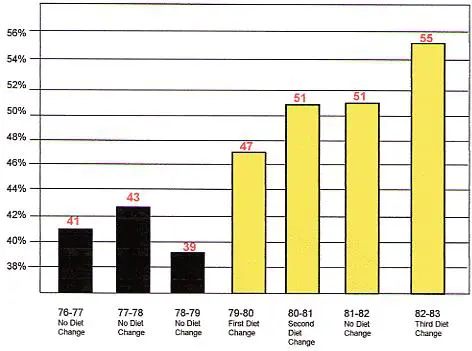Does the Gut Microbiome Play a Role in a Kid’s Healthy Diet?
In this article, I will review a classic nutritional study titled: The impact of a low food additive and sucrose diet on academic performance in 803 New York City public schools, published in 1991.i My purpose in reviewing this study is to propose a microbiome-based explanation for the improved academic performance that the children achieved.
Stephen Schoenthaler, Ph.D., obtained funding and permission to improve the quality of food served in the breakfast and lunch meals provided in 803 New York City public schools for four years, from 1979 to 1983. During these four years, over one million children ate either one or two meals a day at school, five days a week.
Measurement of Academic Performance
The California Achievement Test (CAT) is a nationally recognized standardized test that measures achievement in Reading, Language Arts, and Math.ii This test, administered once a year to children in grades K-12, provides educators and parents with a measurement of achievement for a school and individual students, compared to overall national scores.
The year before this study began, the New York City schools’ national rank was below the national average at the 39th percentile. And in previous years, the ranking of New York City schools seldom varied more than 1%.
Study Design & Outcomes
1979-80: 8.1% higher CAT scores: During the 1979-80 school year, most foods containing significant amounts of sugar and two commonly used food colorings were eliminated and replaced with healthy foods. This change resulted in an average 8.1% increase in the CAT scores in the New York City schools.
1980-81: an additional 3.8% increase in CAT scores: during the 1980-81 school year, foods containing the remaining food coloring and flavoring agents were removed from the school meals.
1981-82: essentially no change in CAT scores: The investigators maintained the dietary improvements from the first two years this year, but no additional changes were made. As expected, the CAT scores from this year were virtually the same as the previous year.
1982-83: an additional 3.7% increase in CAT scores: During this final year of the 4-year study, all foods containing the preservatives BHT and BHA were removed from the school meals, which resulted in a 3.7% improvement in CAT scores over the previous year.
Results: 15.7% overall gain in CAT scores: Removing foods with high sugar content and synthetic food colorings, flavoring agents, and preservatives and substituting with more fresh vegetables, fruits, whole grains, and non-processed foods enabled over one million kids in 803 New York City schools to elevate their CAT scores from 39.2% at the beginning (below the national average), to 54.9% (above the national average), compared to the rest of the schools in the nation that used the same standardized CAT test. That’s an impressive overall gain of 15.7%. Feeding these kids healthy food enabled them to become more intelligent!
Result #2: Before this study began, schools with more students eating breakfast and lunch had the lowest CAT scores. At the end of the study, this situation was reversed. The more students who ate meals at school, the higher the school’s CAT scores.
The chart below shows the average of over a million students, but not all children improved the same way. Before the dietary changes, 12.4% of the students were two or more years behind their grades. By the end of the study, only 4.9% of students were below their grade level.
Chart showing NYC schools’ improvements in CAT scores during this study
The Microbiome Perspective
The improvements in students’ academic performance from this study are generally assumed to be related to removing sugar and food additives and eating foods that provide higher levels of vitamins, minerals, and other nutrients. I am sure these factors played a role, and I don’t want to minimize their importance. However, I believe essential insights can be gained by considering how improvements in the microbiome may have contributed to the advances in academic performance.
An old saying is that “You are what you eat.” However, it is more accurate to say, “You are what you absorb.” Switching to a healthier diet enhances the growth of beneficial probiotic bacteria and helps create a healthier microbiome ecosystem throughout the gastrointestinal tract. Digestion of food and absorption of nutrients takes place throughout the gastrointestinal tract. Dietary improvements and the resulting improvements in the microbiome can improve digestion and the absorption of nutrients.
For a long time, experts assumed that humans obtained all their nutrients from the foods they consumed. However, it is now understood that numerous nutrients (B vitamins, vitamin K, and amino acids) are postbiotic metabolites produced by probiotic bacteria.
The improvements in food quality enabled the students to consume a greater quantity and diversity of dietary fibers and polyphenols, the primary foods for probiotic bacteria. In addition to promoting the growth of probiotic bacteria, the dietary improvements also enabled the probiotic bacteria to produce a greater quantity and diversity of postbiotic metabolites.
It can be assumed that many students had some degree of dysbiosis and intestinal permeability when this study began. Dysbiosis and intestinal permeability can contribute to brain fog and affect cognitive functioning. When the students started consuming healthier food, the resulting improvements in the microbiome probably helped reduce and/or heal leaky gut, which would also contribute to the students’ gains in academic performance.
Healthy Tips to Kick-start the New School Year
As the summer starts winding down and Fall approaches, it’s time to start getting kids of all ages ready for school. As children rejoin their classmates on the playground and in the classroom, they need to be in good health to hit the ground running!
That means at the top of every parent’s to-do list should be checking in on the health and wellbeing of their child. Getting your kids back to school ready involves more than shopping for school supplies and new clothes. Caring for their health will ensure they are physically and emotionally prepared to return to school. To kick-start, the new school year, consider these healthy tips.
TEACH GOOD HYGIENE HABITS
The most effective way to avoid spreading germs is proper hand washing. Encouraging your kids to sing the alphabet or the Happy Birthday song from beginning to end will teach them how much time should be spent on this task. Everyone should wash the fronts and backs of their hands and in-between fingers. Hand sanitizer is a good alternative when soap and water aren’t available, and teaching them to sneeze into the crook of the elbow or sleeve will help prevent spreading germs.
VISIT YOUR HEALTHCARE PRACTITIONER
An annual check-up will ensure your kids are healthy and virus-free before returning to school. Make sure their immunizations are up-to-date, too. Every state requires vaccinations for public and private school children at different grade levels.
GET BACK INTO THE ROUTINE
Shift your kids back to a school-year bedtime routine at least a week before school starts. This is also an excellent time to stop playing electronic games and watching TV and begin reading or playing quiet games an hour before bedtime to help with the transition.
PROVIDE HEALTHY MEALS
Provide healthy meal options for your kids, including breakfast. Students who eat breakfast are more alert during class than those who don’t. Plus, the high-nutrition foods and adequate rest will help fight infections.
Vitamin-Producing Probiotic Bacteria
STAY HYDRATED
Keeping your kids hydrated with healthy drinks like water and nut milk has many benefits. It will help prevent fatigue, improve mood, aid digestion, and enhance brain function.
Avoid sugary drinks such as soda, sports, and energy drinks, as they are often packed with sugar, caffeine, and other unwanted ingredients. Too much caffeine can increase heart rates and blood pressure, interrupt sleep, and cause nervousness and irritability.
MANAGE ALLERGIES
Managing your kid’s allergies at school is integral to caring for their health. Seasonal allergies affect as many as 40% of U.S. children, causing many to miss school. Even if they don’t miss school, allergies can get in the way of a productive school day.
Symptoms like fatigue, headache, sneezing, runny nose, watery eyes, and itchiness can get in the way of attention and concentration. Food allergies are prevalent, too.
If your child has allergies, talk with your child’s teacher and school nurse about how to manage them during school.
STAY ACTIVE
Your kids have probably been active all summer, and it’s essential to keep moving. Kids typically sit most of their school day, so incorporating sports and exercise into their daily routine will keep them focused, improve behavior and boost positive attitude.
If possible, enroll your kids in after-school activities. Enjoy a family walk or bike ride and encourage them to keep moving. If you engage in physical activity, they will follow along.
Exercise Promotes Beneficial Bacteria! – Postbiotics Produced by Workouts
NURTURE GUT HEALTH
Your child’s gut health is vital for several reasons; it contributes to their metabolism, immunity, and overall physical wellness and can also affect mental health. Because certain essential bacteria live and thrive in your gut, you’ll want to keep them as healthy as possible by eating a nutritious high-fiber diet and using a high-quality probiotic supplement that delivers restorative postbiotic metabolites.
CALM WORRIES AND ANXIETY
Separation anxiety, social anxiety, fear of not fitting in, or feeling the pressure to stay on top of grades and activities is a growing concerns for children. Make sure your kids know their teacher, class schedule, and any other changes they might encounter. Planning a tour of the school and classroom or a meet-and-greet with the teacher is an excellent way to help your kids acclimate before the first day.
CHOOSE THE RIGHT SCHOOL BACKPACK
These days, backpacks are heavier than ever. The wrong type of backpack and wearing it incorrectly can lead to back pain. Along with cool colors and designs, choose a pack for your kids that will be comfortable and won’t cause pain. Also, show them how to wear their backpacks correctly to prevent back problems.
i Schoenthaler S. The Impact of a Low Food Additive and Sucrose Diet on Academic Performance in 803 New York City Public Schools. International Journal for Biosocial Research, 1986, 8(2); 185-195.
ii Seaton Testing Services. https://www.setontesting.com/product/cat-survey/







